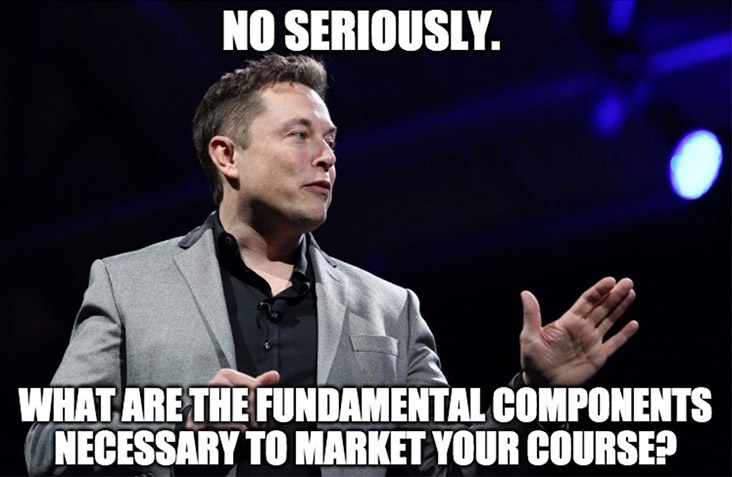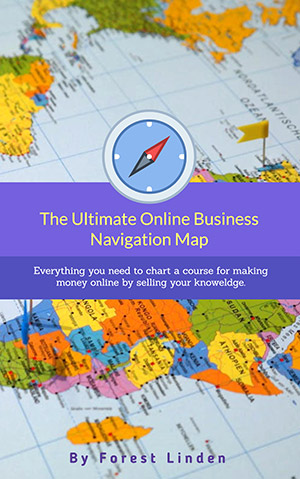How To Invent New Marketing Methods Like Elon Musk

Something’s been on my mind for a long time around marketing for knowledge products like online courses. I will often fall asleep thinking about this, with notes and diagrams drawn on a giant whiteboard in my mind.
It feels at times to be an intractable problem. Other times, it feels like a thoroughly entertaining pursuit worthy of years of focused concentration. And if you could see what I’m doing in my mind with all these ideas, you’d know why my son calls me “The Acting Director of Loony Inventions.”
The nut I’m trying to crack is this: how can I create a new way of marketing online courses that doesn’t involve doing a big product launch? By “product launch,” I’m referring to the time consuming, stressful, costly “product launch formula” style of launch. They can work well, but they’re stressful and sometimes don’t resonate with every market, especially when they involve more aggressive marketing tactics.
I have pieces of a new method on the big whiteboard in my mind, but it’s not yet ready to share. Despite it not being ready, I’d love to share the thinking process I’m using to work on building this new marketing method.
Why? Because I have a feeling that just knowing how to do it could help you create new ways to market and sell your online knowledge products. Plus, you’ll end up with an internal mental whiteboard, which comes in handy.
And who knows, maybe you’ll come up with a new way to launch online courses without launching, which means I won’t have to. Then I can go back to my other favorite thing to visualize while falling asleep: me flying around on a dragon. (It’s way better than counting sheep.)

The Problem
You may already be familiar with the Product Launch Formula style of launching an online course, but if you’re not, here’s a brief overview of what that is:
In 1996, Jeff Walker started using a method of selling his digital knowledge products that involved releasing a series of free pieces of content followed by a registration period.
The method worked incredibly well for him.
Over time, he built his strategy up into a repeatable method and started teaching others how to do this. The people who tried his launch method saw incredible results as well. In 2005, he launched a robust online course called Product Launch Formula (or PLF for short) and started teaching a much wider audience on how to do this style of internet marketing.
He’s launched that course every year since and tends to sell several millions of dollars worth of spots in that course each time he launches it.

Many, many people use the PLF style of launching. It’s a method that works well most of the time if you design each piece of the launch process smartly. I bought the PLF course myself and used it straight out of the box. Using the PLF method, in eleven months I went from no website, no business, and no email list, to $100,000 in income from my first two launches.
Hundreds of other online entrepreneurs do larger launches than that every year with this method. And we still use a modified version of PLF to launch my wife’s year-long course, The Art of Money, each year, with those launches doing mid-six-figures.
Though it may sound simple at first, pulling off a successful launch is not easy. At all.
For my first one, I spent three solid months working 50 hour weeks to get everything ready for the launch.
That included creating four pre-launch videos where I was on camera teaching, setting up the full tech system for the launch, writing a dozen launch emails, creating the launch funnel pages on my site, writing another dozen emails for the affiliates that were promoting my online course to their audiences, and creating swipe copy for them to use in their marketing materials about my course (among 34 other smaller things.)
And all of that? Just got me to the point of starting the launch. Running the launch is a whole other thing.
Lasting a week or two, a piece of free content is going out every couple of days. Emails need to be formatted and sent out to your list. Affiliates send in emails asking questions, and they need responses. Conversations are happening with prospects in the comments below the videos you post, and you need to respond pretty quickly to keep conversations with prospects happening.
Whew. It’s a lot, and I’m just touching on the main headlines of what happens in a launch.
Typically, at the end of your free training series, you open up your online course for registration for a short period, and then the stress starts to ramp up. If you’re not careful, your emotions can become directly tied to the number of sales coming in…or not coming in.
And with human nature being what it is, 70% to 80% of the people who will buy your online course will wait until the last 24 hours before registration closes to decide to sign up. Those last 24 hours can be a wild ride, whether it’s going well or not.
The bottom line is that one, even when launches go well, they require months of work to prepare for and can be extremely stressful to manage.
And two, more and more people around the world are seeing people launching online courses using this PLF method, and it doesn’t always work well in some markets when it’s infused with aggressive marketing tactics.
As I’ve mentioned, my wife and I have created a version of the PLF launch method that is not aggressive at all. In fact, it’s downright gentle and respectful through and through.
Our modified PLF launch style works really well with her market, so the natural question is, why am I losing sleep trying to find a way to launch online courses without using our modified version of a PLF launch?
Because even our modified version takes a couple of months of prep time, and it’s still quite stressful on our whole family every time we launch.
I have a hunch there’s another way to market and sell online courses that would be better for everyone: business owners and customers. Hence, my endless loony noodling on the whiteboard in my mind.
The Process
Here’s the thing about every single marketing strategy or tactic that you’ve ever learned about, offline or online: the people who created those tactics are making things up.
Let me say that again, but a little louder, because this is important: EVERYONE IS MAKING UP THESE MARKETING TACTICS.
Here’s a shortlist of some of the more common marketing tactics:
- Offering a free ebook to build your email list
- Publishing lots of free blog posts or podcasts to bring traffic to your site
- Offering content upgrades at the bottom of blog posts
- Exit intent pop-ups to get people to subscribe to your newsletter or sign up for your free offer
- The Product Launch Formula
- Running webinars that teach and then sell people an online course at the end
- Affiliate marketing where other business owners promote your online course and get a commission on sales.
Someone created every single one of those tactics. We all go about our life here on Earth without ever seeing a given marketing tactic, and then one day comes along and WHAM, someone starts doing a new marketing thing that didn’t exist.
People are creating marketing methods that didn’t exist before.
In other words, they are making things up as they go.

So, the question is, what’s to keep you and me from creating new marketing methods? No one says you have to learn and follow other people’s strategies and tactics, even if those methods work for them with their markets and their products.
It’s fine if you want to take that path. Really. I took it myself for many years. When you’re new to marketing and selling things online, it’s much easier to buy an online course and learn the easy-to-follow formula.
Formulas and step-by-step, lego-like instructions for how to market and sell things online have their place, for sure. They helped me, and they’ve helped many other people who are new to the journey of creating knowledge products and selling them online.
But it can be easy to look at the formulas and methods out there and get frustrated with having to learn marketing and selling methods that don’t feel good.
I want you to know something though: you can create your own marketing and selling methods that both work and feel good to you.
But wait…how can you create new marketing methods if you don’t know for sure whether or not they’ll work?
Why, physics, of course! (Before you bolt, hold on. There’s no painful math coming. Promise)

To be more specific, there’s a method of thinking that physicists use called “reasoning from first principles.” This type of thinking is at the root of the most innovative products and companies in history, such as Tesla and SpaceX.
Elon Musk, CEO of both Tesla and SpaceX, used this reasoning from first principles thinking to radically shake up not just the automotive industry, but also the rocket and spacecraft industry.
I was fascinated with learning the process Elon used to accomplish those things, so I started researching anything and everything I could about this reasoning from first principles concept.
It took me a long time to find clear descriptions of how to think about creating solutions to problems in this way, but it finally became clear to me.
Here’s how to begin. Ask yourself this question: “What are the fundamental components necessary for [insert the result you want to achieve here.]”
For our topic, this question would look like this: What are the fundamental components necessary to market and sell an online course?
Answering that question isn’t going to be easy if you don’t have the background knowledge that would allow you to know what things are necessary. But hey, I didn’t say this was an easy way to come up with new marketing methods. It is, however, a powerful way for you to go about creating new ways of doing things.

Here’s how I would go about starting to answer that question.
Reasoning from first principles is about breaking things down to their fundamental components. Those fundamental components are like the “concept atoms” that will make up the matter that becomes your method.
What are the fundamental things you need to market and sell an online course? Here’s a shortlist that will serve as an example of this thinking process:
Things you need to do:
- Communicate words and concepts to people in your market.
- Show how your course can solve a problem or problems.
- Show how your course can make your customer’s life better in some way.
- Explain your prospect’s problems and challenges in a way that allows them to feel like you understand them and speak their language.
- Address people’s objections to buying your course.
- Give people a reason to buy your course now, rather than put it off until later.
- Allow people to get a sense of you to a degree where they can come to know, like, and trust you.
- Let people know that you’re an expert and that you can help them with their problems.
- Show prospects that there are other people who have used your course or product and have gotten results.
- Show people what they will learn in your course.
- Give prospects useful free information that can help them start making changes in their life right away, even if they don’t buy your course.
There’s more to that list, but that’s enough to get us started.
That is simply a list of fundamental components to marketing and selling an online course. How do I know that those things are necessary components to marketing an online course? I’ve been studying it and experimenting with different marketing methods for a long time. You can do the same yourself.
If you look at almost any of the popular methods of marketing and selling online courses, you’ll see all 11 of those fundamental components in action.
Look closely at any good webinar, like the ones Amy Porterfield does to launch her online course, or look at the launch videos that Stu Mclaren or James Wedmore do to launch their online courses. You’ll see the fundamental components I listed above in action.
Watch how Seth Godin markets his online courses (which is quite different from how everyone else does it), and you’ll still see those 11 fundamental components in the way he markets and sells his courses.
Everywhere you look in the internet marketing space, you’ll see those 11 fundamental components present in nearly every strategy and tactic people are using. They’re like the raw ingredients that people are mixing in different ways to create their marketing methods. They’re the atoms that make up the building blocks of all modern marketing for digital knowledge products.
Once you identify a list of fundamental building blocks for the thing you’re trying to do (marketing in this example), you then look for novel ways to combine those building blocks into something new.
Webinars, for example, are one example of combining all of those fundamental building blocks in a way that can work well for selling online courses. But guess what? I hate doing webinars, so I don’t do them.
Yes, they can work well. They can make you a lot of money and get a lot of people in your online programs, but I can’t stand doing them. It’s a way of marketing that doesn’t sit well with me when I’m the one that has to perform the webinar.
But here’s the thing: if you see people teaching marketing methods that you don’t want to do, YOU DON’T HAVE TO DO THEM.
There are many, many ways of combining those fundamental components of marketing and selling an online course. A webinar is just one expression. A Product Launch Formula video-based launch is another expression. Creating a free series of podcast episodes to market and sell your course is another. You can even market and sell your online course with a series of simple blog posts and emails to announce the blog posts.
But all of those things I just mentioned are examples of things that other people have done.
You don’t have to be limited by what others have done. You can create a list of fundamental components of marketing and selling an online course and create your own freaking badass method to market your online course that no one has ever seen!
That’s the power of using this reasoning from first principles method of thinking. It allows you to create something new that didn’t exist before. And you can have a reasonable amount of certainty that your new method will work.
Why? Because you will have included the fundamental principles that are present in almost all other successful online marketing and selling methods.
Alright, as the character Mark Watney in the movie “The Martian” says, you’re going to need to science the shit out of this.
So go make your list of fundamental components and create something new that the world has never seen before.
p.s. After you’re done creating your never-seen-before marketing method, you’re going to need some software to pull it off. Find out why this all-in-one website and tech system is my go-to favorite platform for marketing and selling digital knowledge products like online courses.

